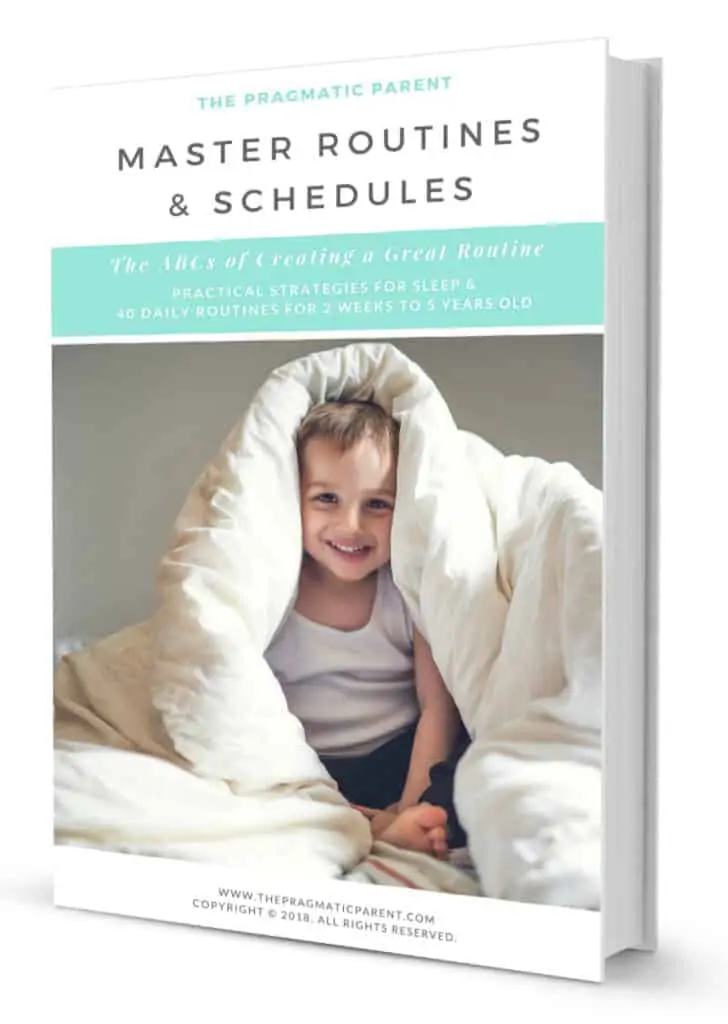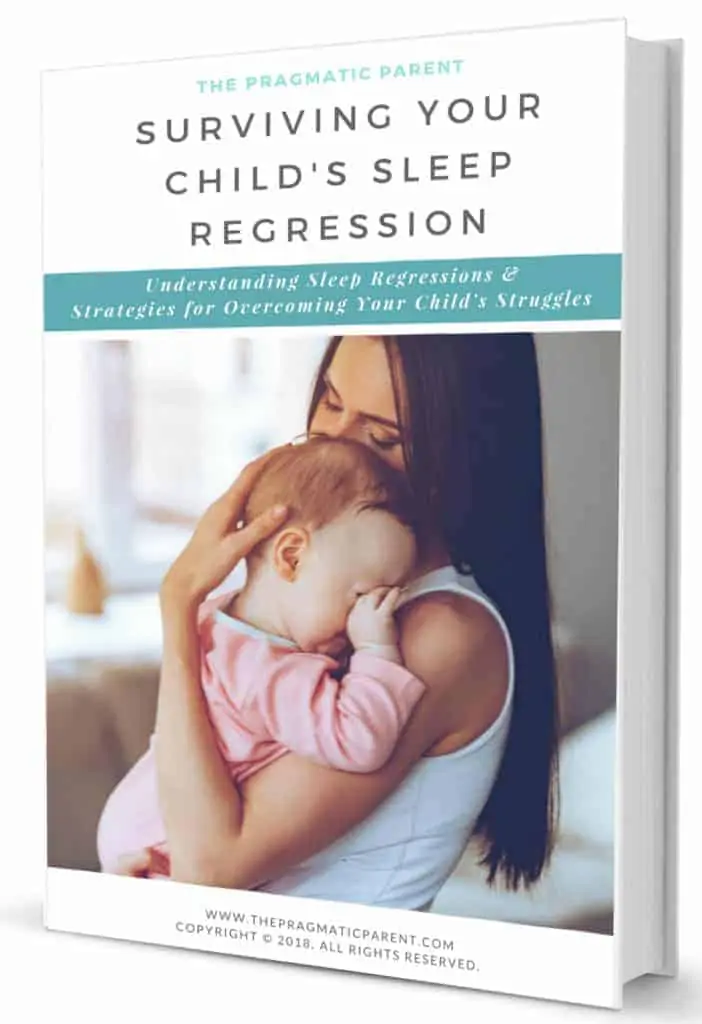Understanding your child’s body language and sleep signals if they’re ready to move to one nap a day or might only be going through a sleep regression. Check the Sleep Litmus Test to see if it’s time to transition to one nap a day or if your child isn’t *actually* ready to give up a nap. Expert tips to master the nap transition and adjust your day for optimal nap time success.

You’ve mastered your daily routine and your child is sleeping well at naptime and bedtime. But just when you feel like you’ve earned another Mama Badge, but then naps start going haywire. They wake up after 30 minutes instead of an hour, and a mini revolt against being put down for naptime means that sleep habits need once again, another shift.
Back to the drawing board to figure out what’s going on and what tweeks to sleep you need to make this time.
Two things can be going on here. Your child may be going through a sleep regression or they could be ready to give up their second nap.
What a Sleep Regression Looks Like
- All of a sudden, your child is not sleeping or napping well
- Fighting naps but if they don’t take one, is cranky and irritable
- Does not seem well-rested and the without a nap, the entire day is thrown off
Sleep regressions are normal parts of a child’s sleep progression, but don’t require drastic changes such as dropping a nap. Being consistent with your routine and possibly putting them to sleep 15-30 minutes early so they aren’t going to bed overtired can all be solutions for changes within a few days.
Signs Your Toddler is Ready to Give up One Nap
Around the 12-month mark, but it can be as late as 18-months, toddlers become ready to give up one of their naps. Toddlers sleep more soundly at night and are getting the quality rest to be awake longer during the day before needing to rest again.
Your Child MayBe Ready to Drop a Nap If They…
- Become irritable and cranky when you try to put them to sleep
- Wide awake at nap time and will fight it all together
- Waking up early from one or both naps
- Your child can go for longer periods of time without melting down
- If your child misses the second afternoon nap and makes it to bedtime without melting down
Consistent patterns of change in your baby’s sleep over the course of two weeks indicate it may be a good time to transition to one nap a day.
Litmust Test to Know If It’s Time
If you make the switch before your child is ready to give up one nap, this can cause an onslaught of problems like a sharp increase in night-waking, overtired and cranky moods and being more prone to outbursts which can be difficult to remedy.
Make sure your baby passes this sleep litmus test before you make the big switch.
- Waking Up at Night
- Your child make seem more energized and you may think it’s time to switch to one nap, but their brain could be really exhausted. Are you seeing an increase in night-wakings? This is a surefire sign he is exhausted and struggling with sleep because of being overtired.
- Does he sleep through the night consistently?
- Toddlers who are getting 10-11 hours of quality, uninterrupted sleep all night long may be ready to make the transition. Kids who aren’t sleeping through the night, are not ready.
- How long does it take to fall asleep for the FIRST nap?
- When you put your son to sleep for the first nap, is he falling asleep quickly or is there a gap between when you put him down and when he falls asleep?
- Track for a week or so how long of time is takes for your child to fall asleep. A big, and consistent chunk of time to fall asleep may mean it’s time to push back the morning nap to a single, mid-day slumber.
Options to Try Before Making the Switch to a Single Nap
If your child is still taking two naps a day and the morning nap goes well but she wakes up early from the afternoon nap, you may try shortening the morning nap to spread out the rest between the two.
For example:
- Morning nap is 1.5 hours
- During the afternoon nap, your daughter wakes up at 1 hour and is cranky for the rest of the day
- Shorten the morning nap to be 1 hour and 15 minutes and this will balance out the afternoon nap to be the same
Download Your Routine Tracker – The Starting Place for Creating a Better Routine and Great Sleep Habits
Making the Transition to One Nap a Day
The phase between needing one and two naps a day is murky and your child can struggle with the limbo trying to figure out what they need for a couple weeks. This is where, when you decide it’s time to make the move, you can steer them towards a single mid-day nap.
Start by pushing the morning nap later and later by 20 minutes for a couple of days. Your goal is to eventually push the single nap to lunchtime without putting them to bed at the point where they’re exhausted.
For example:
- Old Normal: 10am Morning Nap
- Days 1 – 2: 10:20am Nap
- Days 3 – 4: 10:40am Nap
- Days 5 – 6: 11am Nap
- Days 7 – 8: 11:20am Nap
- Days 9 – 10: 11:40am Nap
- Days 11 – 12: 12pm Nap
*Some kids can move quicker than this based on readiness so you may make the move by 30 minutes a day to get to the new mid-day nap time.
If your child gives up their morning nap but can’t make it to the afternoon nap without melting down, and you think you’re ready to move to one nap a day, set a new naptime meeting in the middle.
For example
- Morning nap is at 10am and the afternoon nap was at 2pm
- Set the one nap a day at 12pm so you aren’t putting them to sleep overtired and cranky but also not early enough so they’re overdue for bedtime
Your tired toddler should be sleeping between two and two-and-a-half hours once they move to a single nap. If they wake up too early, try to let them self-soothe or help them soothe themselves back to the sleep for the remainder of the nap.
Until your toddler gets the hang of the mid-day nap, you may need to put them in the car seat for a quick drive or push them in the stroller around the neighborhood for a quick cat nap to ensure they don’t hit bedtime at the point of melting down.
When needed, it’s also OK to let your toddler take two naps when they seem like they require extra rest or life has gotten particularly busy lately. An occasional double nap day could help them get back on the track.
Adjust Bedtime to Help with Naptime
As your child moves to a single nap, you’ll want to watch bedtime and possibly move it earlier. As a rule of thumb, you don’t want to put your baby to sleep after the point where they’re overtired, cranky and melting down. You want to put them to sleep before this time.
A child who is overtired will lighting fight bedtime and having a harder time putting themselves to sleep peacefully.
Stick to your bedtime routine, but bump dinner a little earlier and push bedtime up by 30 minutes or as necessary based on your child’s mood and temperament at nighttime.
When you start considering making the move to a single nap, watch and log your child’s sleep patterns for two weeks to see if they really do tick off the three items on the sleep litmus test and their body is actually ready to make the transition. If not, this could be a sleep regression period and you can read more about this phase and how to get back on track.
Download Your Routine Tracker – The Starting Place for Creating a Better Routine and Great Sleep Habits
Awesome Parenting Tools for Sleep & Routines:

Learn how to start creating a routine, establishing wake up and bedtimes, strategies for working through nap transitions, prepping for daylight savings time to keep your routine on track and logging your baby’s sleep patterns… all helping you rock a routine and simplify life when your days flow.
Surviving Your Child’s Sleep Regressions Ebook
Additional Reading on This Topic
- Scared of the Dark: How to Conquer Nighttime Fears
- How to Ease Separation Anxiety in Babies, Toddlers & Preschoolers
- 8 Common Toddler Sleep Problems & How to Handle Them
- 7 Ways to Beat Bedtime Stalling with Young Kids
- Is Your Kid Waking Up Too Early? How to Fix It
- 10 Helpful Ways to Calm the Kid Who Fights Bedtime
- Toddler Sleep Regressions: What You Need to Know About Your Two Year Old’s Sleep
- How to Establish a Peaceful Bedtime Routine for Your Baby
- How to Survive the 18 Month Sleep Regression & 2 Year Sleep Regressions Without Going Crazy
Want even more?
Shop All Parenting Resources
Shop all of our parenting resources from self-regulation tools and managing big emotions to building self esteem and confidence. There are resources for all seasons of life!








Hi, I have a 13.5 mo old that has been showing me readiness signs since 11/12 months old. He got sick around 12.5 mo old and was taking two solid naps a day. But as soon as he got better he started resisting his morning nap and wanting to go down later. Or if he went down good for the morning nap he started to refuse the afternoon nap. We have tried a couple of days this week to do one nap. Sometimes the nap will only be 45 min. But if we put him down at 1pm he will sleep at least an hour and a half. Problem is is that he is getting overtired and having a couple of nighttime wakenings. What should we do?